Created: 2018-11-07
Updated: 2025-09-07
Company - Airbus
Product/Service - Bartolomeo
- Classification
- Miscellaneous
- Category
- ISS Utilization Service
Microgravity Flight Service (LEO)
- Status
- Active
- First launch
- 2020
Bartolomeo
Application areas include (but are not limited to) Earth observation, robotics, material science or astrophysics; payloads can be hosted for institutional and private organizations alike.
Airbus Defence and Space’s All-in-One Mission Service comprises all mission elements into one commercial contract (mission preparation, payload launch, payload on-orbit installation, commissioning, operation, payload data processing and delivery), in order to provide the customer a reliable integrated mission solution. The offer includes the option to return the entire payload or a selected sample to Earth.
Bartolomeo launched on Dragon CRS-20 in March 2020.
Orbital space ageing tests offered for space age materials, 2020-06-04.
Some Examples of Payloads Slated to Fly on Bartolomeo
- The very first payload on the Bartolomeo platform is the Multi-Needle Langmuir Probe (m-NLP), currently the only instrument in the world capable of resolving ionospheric plasma density variations at spatial scales below one metre. This probe, coming from the University of Oslo and Eidsvoll Electronics (Norway) and supported by the European Space Agency (ESA), benefits from the relatively low orbit of the ISS, which puts it near the peak plasma density of the ionosphere. The m-NLP payload will occupy a standard slot for more than three years.
- The European Space Agency’s (ESA) Exobiology Platform mission consists of a set of radiation experiments aimed at better understanding the evolution of organic molecules and organisms in space and will occupy a standard slot for 36 months.
- The German Aerospace Center (DLR) has booked a double slot for its 18-month COMPASSO mission. It is the first in-orbit verification of compact and highly stable laser-optical clocks with a bi-directional optical link to compare and synchronize with highly stable clocks on Earth.
- US communications service provider OnOffBlock Inc DBA Xenesis relies on an ArgUS slot for the year-long in-orbit demonstration of its Xen-Hub, an optical communications terminal capable of establishing high-speed links greater than a gigabit per second.
- Space innovator Launchspace, Inc has booked a slot on the ArgUS for an orbital debris collection and spacecraft shielding demonstration using orbital ‘Debris Impact Pads’, which house a series of sensors that record impact, force and orbital location of debris.
- As part of UNOOSA’s ‘Access to Space 4 All’ initiative, Airbus is providing an ArgUS slot on its 2024 sortie for the ClimCam, a remote sensing camera system dedicated to Climate Change monitoring East Africa. This free-of-charge slot is occupied by the EKU Consortium comprising the Space Agencies of Egypt, Kenya and Uganda.
The first ArgUS Mission, carrying several payloads within one standard slot, is slated for late 2023 and will carry payloads from Germany, Spain, the United Kingdom and the USA.
Notes
Product/Service - Spaceplane
- Classification
- Human Spaceflight & Landers
- Category
- Suborbital Space Tourism
Microgravity Flight Service (Suborbital)
- Fields
- Suborbital
- Status
- Dormant
- First launch
- Dormant
Suborbital Spaceplane
Created: 2021-07-26
Updated: 2025-09-06
Product/Service - ROXY
- Classification
- Space Resources
- Category
- ISRU (In Situ Resource Utilization)
- Status
- Development
- First launch
- 2020
ISRU
MEFAM - The Metals Factory on the Moon.
Status Comment
As of 2024, has worked on many ISRU projects including ROXY, but space demonstration and service plans are unclear.
Created: 2022-09-09
Updated: 2025-09-06
Product/Service - Metal3D, PERIOD
- Classification
- In-Space Manufacturing
- Category
- In-Space Manufacturing
- Fields
- Additive Manufacturing (3D printing)
Large Space Structures
- Status
- Demonstrated
- First launch
- 2024
Additive Manufacturing
The world’s first metal 3D printer for space is on its way to the ISS, 2024-01-31
- The first metal 3D printer for space, developed by Airbus* for the European Space Agency (ESA), will soon be tested aboard the Columbus module of the International Space Station (ISS).
- To create the prototype for the ISS, we had to shrink the printer to the size of a washing machine”. This miniaturisation is needed in order to fit inside the rack in which the printer will be housed on board the ISS’ Columbus Laboratory. “At this size, we can print parts with a volume of nine centimetres high and five centimetres wide,” Girault says.
- The second challenge is safety: protecting the ISS from the aggressive printing environment caused by the laser and the heat it generates. The printer sits in a sealed metal box, which acts like a safe. The melting point of metal alloys compatible with this process can be far over 1,200°C degrees compared to around 200°C degrees for plastic, which implies drastic thermal control.
- Metal 3D printing on board the ISS will help improve understanding of the quality of metal printing in orbit and provide valuable insights into operating a metal 3D printer in space.
- *The metal 3D printer was developed by a consortium comprising Airbus Defence and Space, AddUp, Cranfield University and Highftech Engineering, under a programme of and funded by the European Space Agency (ESA).
- Key figures:
Behind the scenes of the first metal part to be 3D-printed aboard the ISS, 2024-09-06.
First metal 3D printing on Space Station, 2024-06-03.
In-Space Assembly
The European aerospace giant Airbus has commenced the study phase of a factory for assembling an antenna and a satellite in earth’s orbit. Consisting of two robotic arms, a demonstrator of this concept is expected to be functional by as early as 2025. An industrial team is also working on developing a 3D printer for the International Space Station. Through the Horizon 2020 Program, Airbus will lead the PERASPERA In-Orbit Demonstration, or PERIOD project, focusing on building spacecraft while orbiting the Earth.
EU-RISE
The initiative has two separate goals:
- First, do a market analysis of in-space services, in-space assembly and manufacturing, and associated domains, and create two reference scenarios that will be further studied and used to construct an end-to-end demo scenario.
- Second, the demonstration scenario aims to mature building blocks and robotic elements produced in Europe in recent years, and provide an open-source method for ongoing development.
Status Comment
Metal3D printer was demonstrated on the ISS in 2024.
Notes
Created: 2022-10-21
Updated: 2025-09-06
Product/Service - Robotic Arm
- Classification
- Miscellaneous
- Category
- Space Robotics
Robotic Arm
Hardware
- Status
- Development
- First launch
- 2020
Robotic Arm
Detumbler
Airbus launched a device designed to address space debris in Earth's orbit in November 2023.
Created: 2023-02-05
Updated: 2025-09-06
Product/Service
- Classification
- Space Utilities
- Category
- Space Solar Power
Power Beaming
- Fields
- Wireless Power Transfer
- Status
- Concept
- First launch
- Not announced
Created: 2023-03-11
Updated: 2025-09-06
Product/Service - LOOP
- Classification
- Space Stations & Habitats
- Category
- Commercial Space Station
- Status
- Concept
- First launch
- Not announced
- Consulting services for the design and engineering of In-Space and Space Transportation Infrastructure as well as Operations
- Thermal Control Solutions
- Power Generation and Management Systems
- Environmental Control and Life Support Systems
- Outfitting Elements (e.g. Glovebox, Rack, Cooler/Freezer,…)
- Payload Design, Integration and Hosting Services
Status Comment
Assumed to have been merged into Starlab as of late 2023.
Created: 2023-07-16
Updated: 2025-09-06
News, Research, Projects and Patents
| Title | Type | Date | Summary |
|---|---|---|---|
| The Race For Space-Based Solar Power Is Underway | News | 2022-11-30 | |
| Europe will launch a new two-handed robotic arm to the International Space Station soon | News | 2021-07-06 | |
| The new digital factory, hundreds of kilometres above Earth | Article | 2021-02-17 | > Airbus Defence and Space is priming its in-space manufacturing and assembly technologies for orbit |


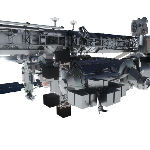

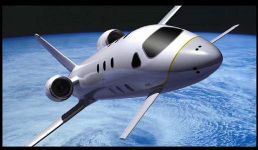
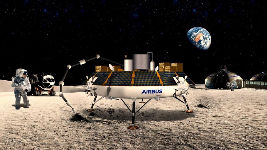
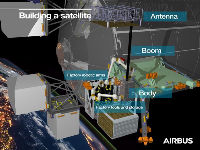
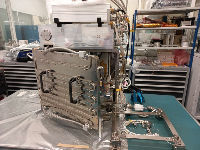


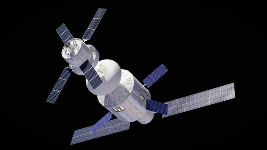













.jpg)

































































